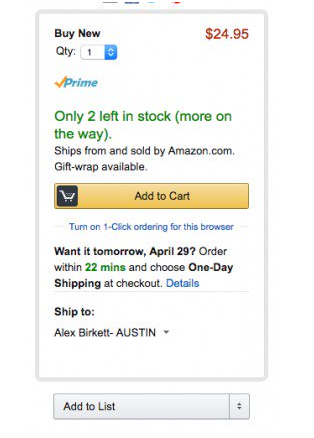https://upcity.com/wp-content/uploads/2018/05/ux.jpg [ad_1]

Successful site design is crucial to your e-commerce business. In fact, you’d be nowhere without it. You depend on your site to attract, engage and convert customers. That’s a lot of responsibility placed on your web pages and understanding how UX plays into the equation is key.
But, with everything you’ve probably heard about UX design, one thing that often gets overlooked is the emotional appeal of your site. The emotional reaction that a consumer has from your site influences how much they’re willing to engage with your brand.
E-commerce businesses can tap into the emotional triggers of persuasive UX design by including certain elements on their web pages. Here are five of the best ways to boost the power of emotional triggers on your site.
Simplified Decision-Making Process
Everyone feels empowered by choices. Having choices and making decisions provides a sense of satisfaction and being in control of your outcomes. But, what happens when someone is presented with too many choices?
There’s a story about a marketing study that illustrates what happens when consumers have too many choices. In this study about jams, a retailer tested what happened when they offered 6 samples versus 24. What they found out was that while more people stopped to have a taste when more samples were offered, the reduced selection of 6 samples resulted in significantly more sales.
There’s an emotionally overwhelming aspect to having too many choices. It’s quite possible that too many choices on your site is the exact reason why your bounce rate is higher than you want it to be.

Simplifying choices in your design will make your site more emotionally appealing to visitors. Choose minimalist designs instead of overcrowding elements and adjust product filters so that searches result in a limited number of options based on distinct criteria rather than pages and pages of generic results.
Social Proof
What other people think about your business is important to today’s consumer. An overwhelming 92 percent of consumers read online reviews. This is up from 88 percent just 4 years ago. Social proof of your integrity as an e-commerce business is vital for people to feel comfortable purchasing from you.

There are multiple ways to incorporate social proof into UX design, reviews being only one of them. Testimonials, subscriber counts, organization memberships, social shares, and validation bars that feature other brands that support your business are all ways to instill a sense of trust with your customers through website design.
Give and Take
When a customer makes a purchase from your e-commerce site, it’s obvious what they’re getting. They’ve agreed to pay you a set amount of money for a product of service. It’s pretty straightforward and should be a done deal.
Except that it isn’t.
Sure, there’s an exchange of value. However, from the customer’s perspective, they could have chosen another business, but they chose you. That should be worth more to you than just the exchange of purchase.
An emotional trigger that e-commerce businesses should be aware of is the “you’ve done something for us, now let us do something for you”. It’s a give and take in which you provide something a little extra to your customers because you value and appreciate them. It’s a nice thank you, and we all respond more favorably when we’re appreciated.
Consider giving customers something for free, like an e-book or guide, free shipping, or even a cart completion discount. Small tokens of appreciation will win them over and that means more conversions.
Scarcity and the Fear of Missing Out
In a digital world, where we pretty much have anything we want at our fingertips, scarcity is something that isn’t encountered the same way that it once was. Just think about it from an e-commerce standpoint. A couple decades ago, if a store was out of a hot item you needed to wait for to be reordered. If you didn’t get there bright and early, you often missed out.
But, today, it’s a different story.
We can instantly purchase anything we want just by scrolling and clicking, in the middle of the night if that’s what works best for us. Scarcity just isn’t something that we’re accustomed to, and the idea that we might miss out on something is almost unbearable.

Including elements of scarcity and missing out is a huge emotional trigger for persuasive UX design. Think in terms of limited time offers, last chances, or indicating the limited number of items you have in stock.
Visual Power
Content and how you use it has a strong effect on how a customer feels emotionally about your brand. Customers want content that’s useful, engaging, and easy to consume. In general, we’re visual creatures and so it’s important to consider the emotional value of visual appeal in your UX design.
For persuasive UX design, graphics and visual elements such as video, win. They’re more enjoyable than text, and make the customer feel less burdened by not forcing them into reading endless text to find what they’re looking for.

CB2 uses several emotional triggers in their site design including a seasonal discount. The homepage also features a large photo of one of their products in action so customers can envision themselves in this tranquil setting.
Visuals are great for decision making too. We process images much faster than we do text. According to MIT, our brains can process and remember an image in as little as 13 milliseconds. That’s basically in the blink of an eye.
Visuals feed information into consumer’s brains faster and easier, reducing the time and energy they need to spend making the decision process. Any time that a customer doesn’t need to overthink a purchase is generally a great outcome for you.
Emotions play an enormous part in consumer habits. UX design that incorporates and appeals to human emotion will generate more conversions and purchases than a flat, lifeless design.
mabc-shadow-none mabc-border-thin mabc-bckg-none" style=" ;">


No comments:
Post a Comment